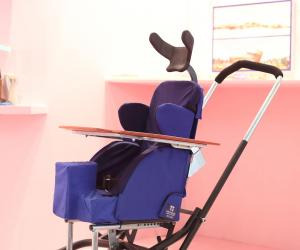From the Series
When Shona McDonald’s second daughter, Shelly, was born with cerebral palsy in 1984, doctors and therapists advised her to put her daughter in a home and have another baby. But that’s not what she had in mind.
After seeing pictures of a special seating support electric wheelchair in a Swedish magazine, she made contact with the Bio-medical Engineering Department at the University of Cape Town, and asked them to build her a similar machine. This led to the first locally-produced battery-powered buggy, and the foundation of Shonaquip itself.
"I had no expertise when I started out. I used to sculpt. I like creating things and solving problems so I was working with a biomedical engineer from UCT, taking ideas and almost like building a puzzle, figured out how to solve this problem," explains McDonald. "At the time there were no wheelchairs that were made for the environments in which we need to use them in South Africa."
Madiba2Go Buggy is the latest incarnation of the original buggy McDonald designed in 1994. It is a rugged and adaptable mobile seating system, especially suited for young wheelchair users living in challenging rural environments.
The Madiba2Go’s lightweight modular seat is detachable from the base frame and can be fine-tuned through multiple adjustments in depth, width, height and angle to effectively manage and improve the posture of each individual user. Crucially, these aspects of the design, when correctly set up, help to reduce and prevent the development of serious life-threatening secondary health complications.
Shonaquip head of design, Guillaume du Toit, explains that the design builds on the legacy of the original Madiba buggy. With the use of design and research they've assessed the functions of the product and the extra needs there might be, taking all the people that interact with it into account:
"We looked, not just at the user sitting in the chair, but also at the needs of the therapist who does the seating and the caregiver who interacts with the product everyday. We’ve tried to take all those needs into account and developed something, which is quite modular, just as robust as the previous one but has a lot more features that you can adjust and customise."
The seat has been designed so that its thin profile becomes almost invisible once the child is seated, shifting the visual focus to the child and enabling better socialisation and inclusion. A sturdy base frame with thick, hardwearing wheels offers a solid and foldable foundation onto which the seat attaches via quick-release plates. The frame folds completely flat for easy storage and transportation, while still maintaining its strength and maneuverability.
It is this kind of inventiveness that earned Shonaquip the Design Indaba Expo Innovation award 2014. The award comes with a R50 000 cash prize courtesy of Adams & Adams.









